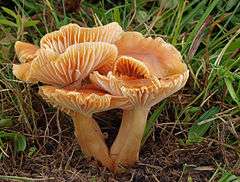Cuphophyllus pratensis
Cuphophyllus pratensis is a species of agaric (gilled mushroom) in the family Hygrophoraceae. It has been given the recommended English name of meadow waxcap in the UK[2] and in North America has variously been called the meadow waxy cap,[3] salmon waxy cap,[4] and butter meadowcap.[5] The species has a widespread, mainly temperate distribution, occurring in grassland in Europe and in woodland elsewhere. The basidiocarps (fruit bodies) are edible and are occasionally collected and sold commercially.
| Cuphophyllus pratensis | |
|---|---|
 | |
| Scientific classification | |
| Kingdom: | |
| Division: | |
| Class: | |
| Order: | |
| Family: | |
| Genus: | |
| Species: | C. pratensis |
| Binomial name | |
| Cuphophyllus pratensis | |
| Synonyms[1] | |
Taxonomy
The species was first described in 1774 by the German mycologist and naturalist Jacob Christian Schäffer as Agaricus pratensis. It was subsequently combined in a number of different genera, before being transferred to Hygrocybe in 1914. The specific epithet comes from Latin "pratensis" (= growing in meadows).[6] Molecular research published in 2011, based on cladistic analysis of DNA sequences found Hygrocybe pratensis not to belong in Hygrocybe sensu stricto and was moved back to the genus Cuphophyllus, in which it had previously been placed.[7]
Description
Basidiocarps are agaricoid, up to 150 mm (6 in) tall, the cap convex at first, becoming flat, umbonate, or slightly depressed when expanded, up to 125 mm (5 in) across. The cap surface is smooth and dry, pale salmon to orange-buff. The lamellae (gills) are waxy, pale cap-coloured, and decurrent (widely attached to and running down the stipe). The stipe (stem) is smooth, cylindrical or tapering to the base, and cream to pale cap-coloured. The spore print is white, the spores (under a microscope) smooth, inamyloid, ellipsoid, about 5.5 to 6.5 by 4.0 to 5.0 μm.[8]
Similar species
Hygrocybe berkeleyi is very similar, but fruit bodies are white (it has sometimes been considered a variety of H. pratensis).[8] Hygrophorus nemoreus is also similar, but is an ectomycorrhizal species, growing in woodland with oaks, and has a distinctly mealy smell.[8]
Distribution and habitat
The meadow waxcap has a widespread distribution, mainly occurring in temperate zones. It has been recorded in Europe, North Africa, North and South America, northern Asia, Australia, and New Zealand.[9][10] Like other waxcaps, it grows in old, unimproved, short-sward grassland (pastures and lawns) in Europe, but in woodland elsewhere. Recent research suggests waxcaps are neither mycorrhizal nor saprotrophic but may be associated with mosses.[11]
Conservation
In Europe, Cuphophyllus pratensis is typical of waxcap grasslands, a declining habitat due to changing agricultural practices. Though the species is one of the commoner members of the genus, it nonetheless appears on the official or provisional national red lists of threatened fungi in a few European countries, including the Czech Republic,[12] Germany (Bavaria),[13] and Poland.[14]
Edibility
Fruit bodies of the meadow waxcap are edible[8][15] and in some countries are seasonally collected for commercial sale in local markets.
See also
References
- "Cuphophyllus pratensis". MycoBank. International Mycological Association. Retrieved 2012-01-10.
- "Recommended English Names for Fungi in the UK" (PDF). British Mycological Society. Archived from the original (PDF) on 2011-07-16. Retrieved 2012-01-10.
- Roody WC (2003). Mushrooms of West Virginia and the Central Appalachians. Lexington: University Press of Kentucky. p. 121. ISBN 978-0-8131-9039-6.
- Bessette AE, Roody WC, Bessette AR (2007). Mushrooms of the Southeastern United States. Syracuse, New York: Syracuse University Press. p. 143. ISBN 978-0-8156-3112-5.
- McKnight VB, McKnight KH (1987). A Field Guide to Mushrooms, North America. Boston: Houghton Mifflin. p. 197. ISBN 978-0-395-91090-0.
- Rea C. (1922). British Basidiomycetaceae: A Handbook of the Larger British Fungi. Cambridge, UK: Cambridge University Press. p. 799.
- Babos M, Halász K, Zagyva T, Zöld-Balogh Á, Szegő D, Bratek Z (2011). "Preliminary notes on dual relevance of ITS sequences and pigments in Hygrocybe taxonomy". Persoonia. 26: 99–107. doi:10.3767/003158511X578349. PMC 3160800. PMID 22025807.
- Boertmann D. (2010). The genus Hygrocybe (2nd ed.). Copenhagen: Danish Mycological Society. p. 200. ISBN 978-87-983581-7-6.
- "Global Biodiversity Information Facility: Hygrocybe pratensis". Global Biodiversity Information Facility. Retrieved 2012-01-10.
- Roberts P, Evans S (2011). The Book of Fungi. Chicago, USA: Chicago University Press. p. 656. ISBN 978-0-226-72117-0.
- Seitzman BH, Ouimette A, Mixon RL, Hobbie EA, Hibbett DS (2011). "Conservation of biotrophy in Hygrophoraceae inferred from combined stable isotope and phylogenetic analyses". Mycologia. 103 (2): 280–290. doi:10.3852/10-195. PMID 21139028.
- "Red list of fungi (macromycetes) of the Czech Republic". Czech Scientific Society for Mycology. Retrieved 2012-01-10.
- "Rote Liste gefährdeter Großpilze Bayerns" (PDF). Bayerisches Landesamt für Umwelt. Retrieved 2012-01-10.
- "Czerwona Lista grzybów Polski". Archived from the original on 2012-04-25. Retrieved 2012-01-10.
- Phillips, Roger (2010) [2005]. Mushrooms and Other Fungi of North America. Buffalo, NY: Firefly Books. p. 74. ISBN 978-1-55407-651-2.